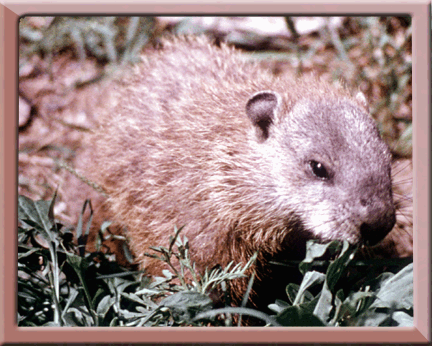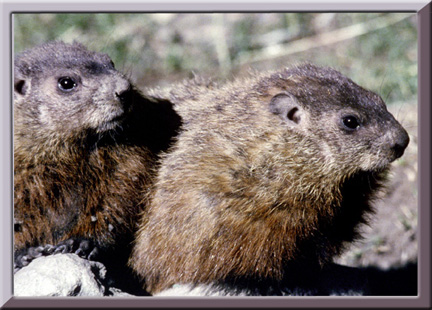Leon M. Lederman Science Education Center
Fermilab Flora and Fauna Virtual Exhibit
Woodchuck

Is a woodchuck a groundhog?
Yes. The woodchuck, Marmota monax, is also called the groundhog or the whistle-pig. This rodent is a member of the squirrel family, and is found across Canada and in the northeastern and midwestern United States. The western United States is the home of its closest relatives, the yellow-bellied marmot and the hoary marmot.
Do we have woodchucks at Fermilab?
Yes! There are a large number of woodchucks on Fermilab's 6,800 acres. Few of their natural preditors are present to control their number. They are a nuisance here because of their tunneling habits and their lack of fear of humans. They dig burrows right next to Fermilab buildings, and even into the berms housing components of physics experiments. To control this digging in undesired locations, the woodchucks are caught using live traps. Then they are relocated to a more remote area of the Fermilab site, giving temporary relief to the problem.
What does a woodchuck look like?
A stout body and short legs give the woodchuck its low-to-the-ground appearance. Its length is 20"-27", and its weight 5-10 lbs. (more before hibernation). Its fur is a grizzled brown, while its feet are a darker brown or black. Typical of the squirrel family, the front feet have 4 clawed toes and the hind feet have 5 clawed toes. The woodchuck has small ears, large black eyes, a furry tail, and sometimes an area of white fur around its nose. Its sight, hearing, and smell are all reported to be keen, and it produces a shrill whistle when alarmed. Although it lives on and underground, the woodchuck can also swim and climb trees.
What kind of teeth does it have?
As a rodent, the woodchuck has a distinct pattern of teeth.
There are 4 large incisor teeth for biting off vegetation and
gnawing through roots when tunneling. These teeth keep growing,
about 1/16" per week. Constant usage wears them down again
by about that much each week. A gap in the teeth follows, then
eighteen chewing teeth. These enable the woodchuck to grind up
the vegetation he is eating. The jaw can move from side to side
as well as up and down, making chewing easier.

What is the woodchuck's burrow like?
Careful observation around the Fermilab grounds will reveal the presence of woodchuck holes. The woodchuck lives alone in a burow near a source of food. Favorite foods are grasses, clover, alfalfa, and crops like corn, so burrows are typically in fields and meadows. There is a separate summer and winter den, and the latter will often be sheltered by trees or shrubs. The burrow dug by the woodchuck may be 5 feet below ground and extend for 30 feet. There is a main entrance hole, 8-12" wide, with dirt piled around it. There are usually several other "emergency exits" from the burrow; they lack the characteristic mound of dirt. Do the woodchuck holes you see at Fermilab appear to be main entrances or back doors? The woodchuck prepares a nesting chamber, where he can sleep, and also makes a separate excrement chamber for his toilet needs. Old woodchuck burrows may be used by other animals, such as skunks and foxes.
Does the woodchuck hibernate?
The winter den is generally used from October through February. With a thick layer of fat in the fall, the woodchuck retires to his winter den, seals the sleeping chamber with dirt, and curls into a ball on his nest to sleep. The woodchuck is a true hibernator. His heart rate slows down to about 4 beats per minute, his body temperature is lowered to about 40 degrees, and his breathing is slowed considerably.
When are baby woodchucks born?
In the spring, the woodchuck awakens. It's soon time to move to the summer den and to begin eating the tender vegetation that appears. There is a brief mating season, and the female gives birth to a litter of 4 or more pups 28 days later, in April or May. The pups are born naked and blind; they are helpless for about a month. Then they begin making short trips outside of the burrows to eat grass and clover. They must then watch out for enemies like foxes, hawks, coyotes, and dogs.
Six more weeks of winter?
Legend says that if the groundhog-or woodchuck-emerges from his den on February 2 and sees his shadow, 6 more weeks of winter will follow. The legend was brought here by German immigrants from Europe, where it was the badger whose emergence from his den foretold more winter to come. Nowadays, civic groups and zoos enjoy having Groundhog Day celebrations, but they don't have any relation to actual weather forecasting.